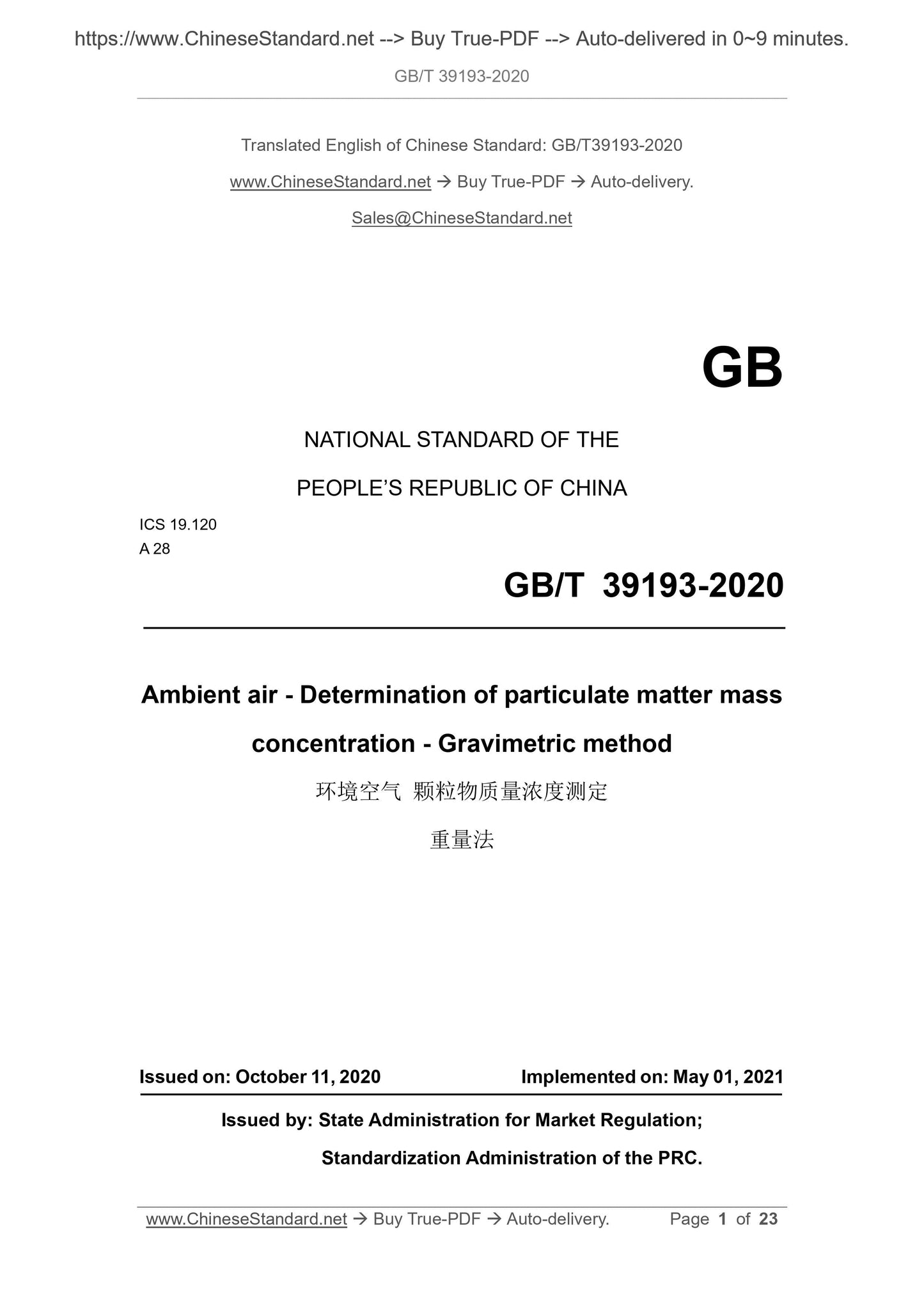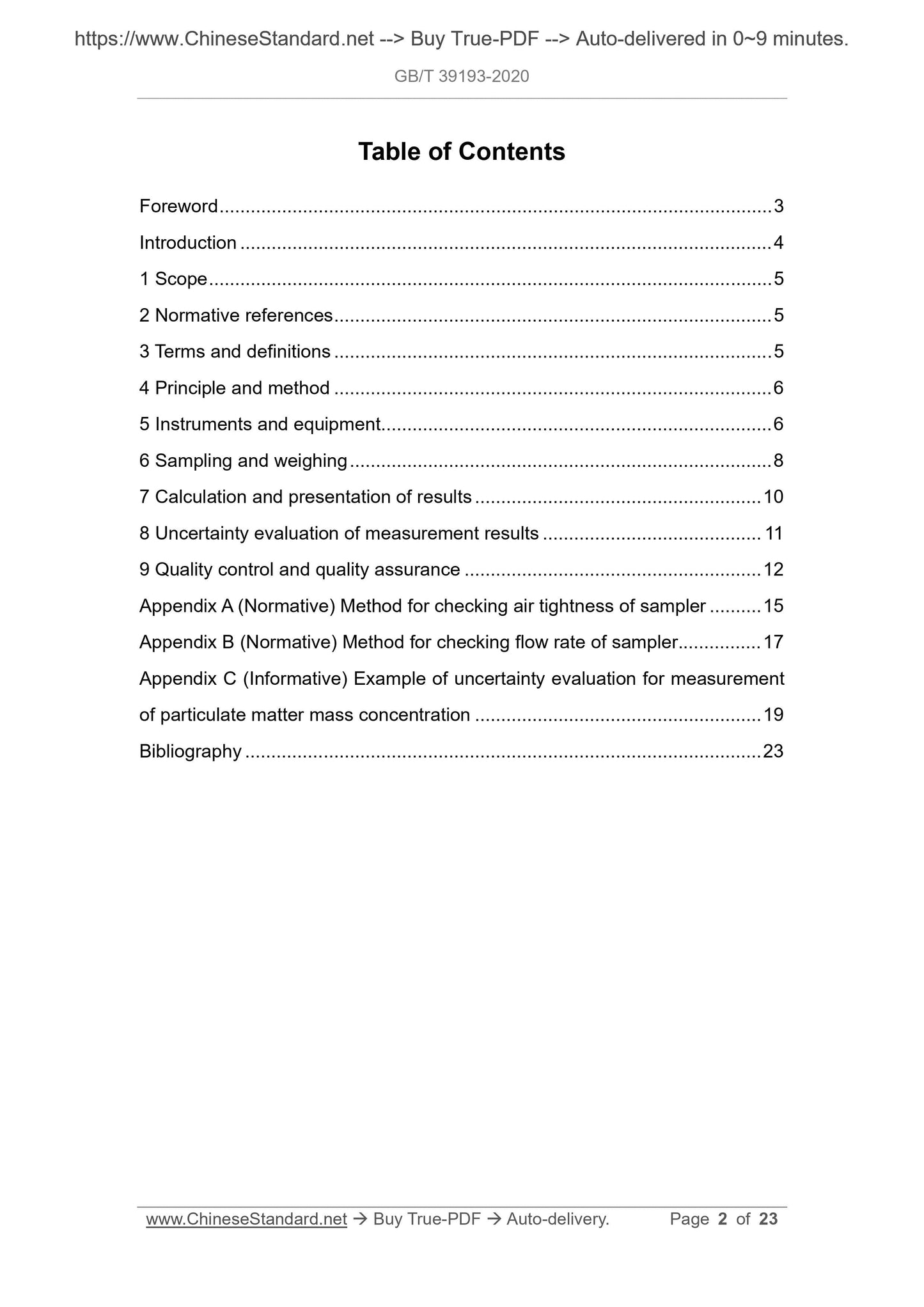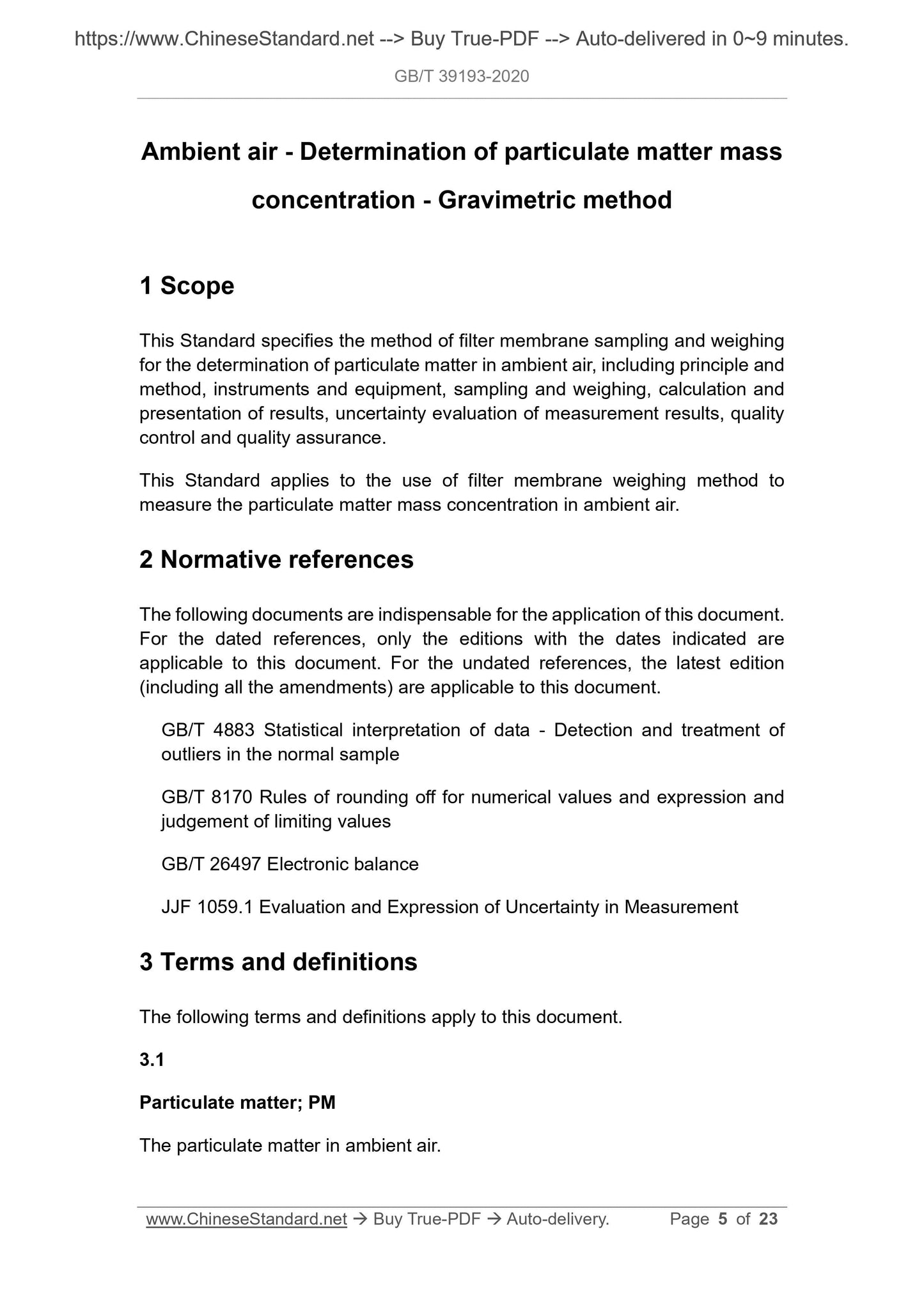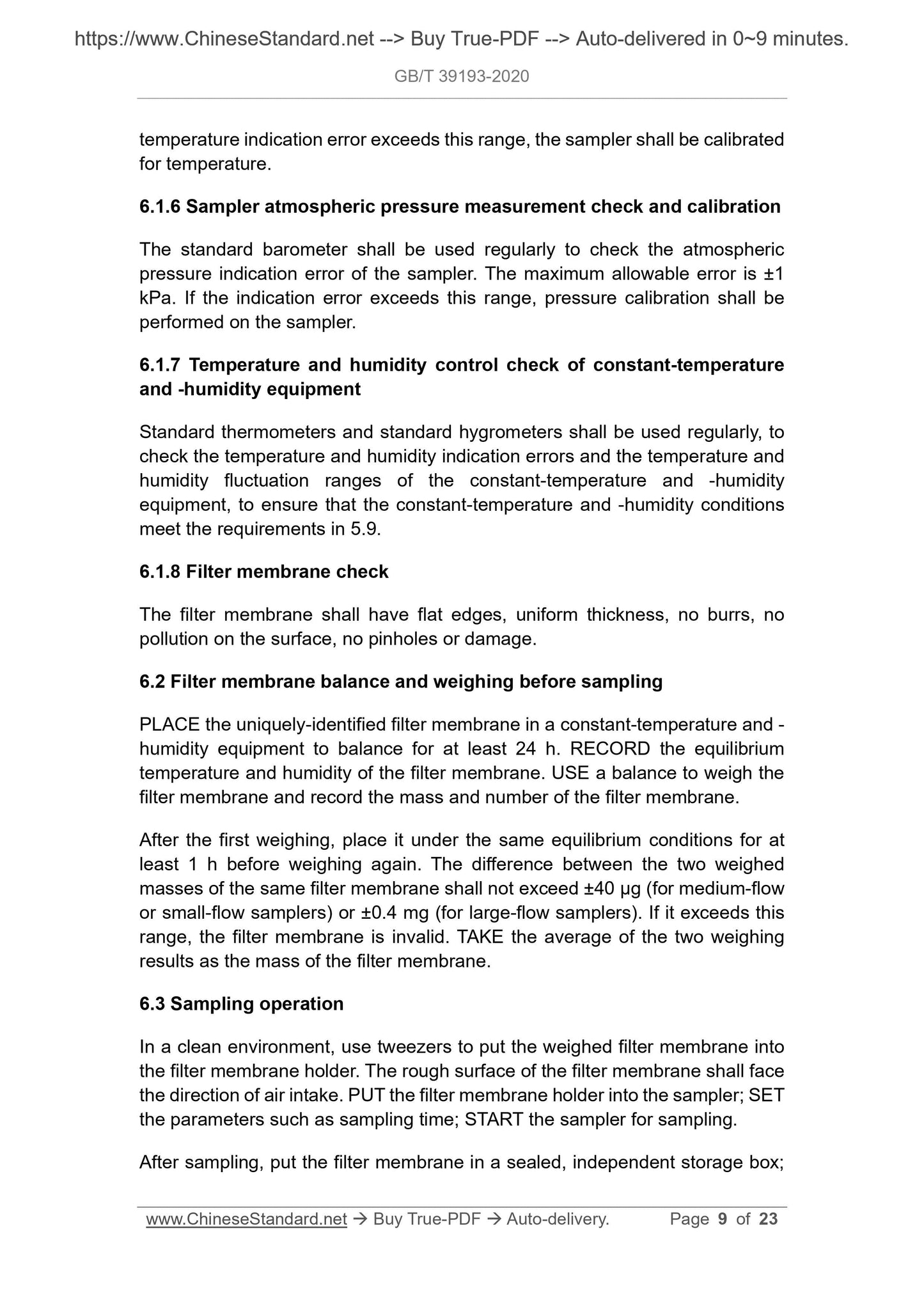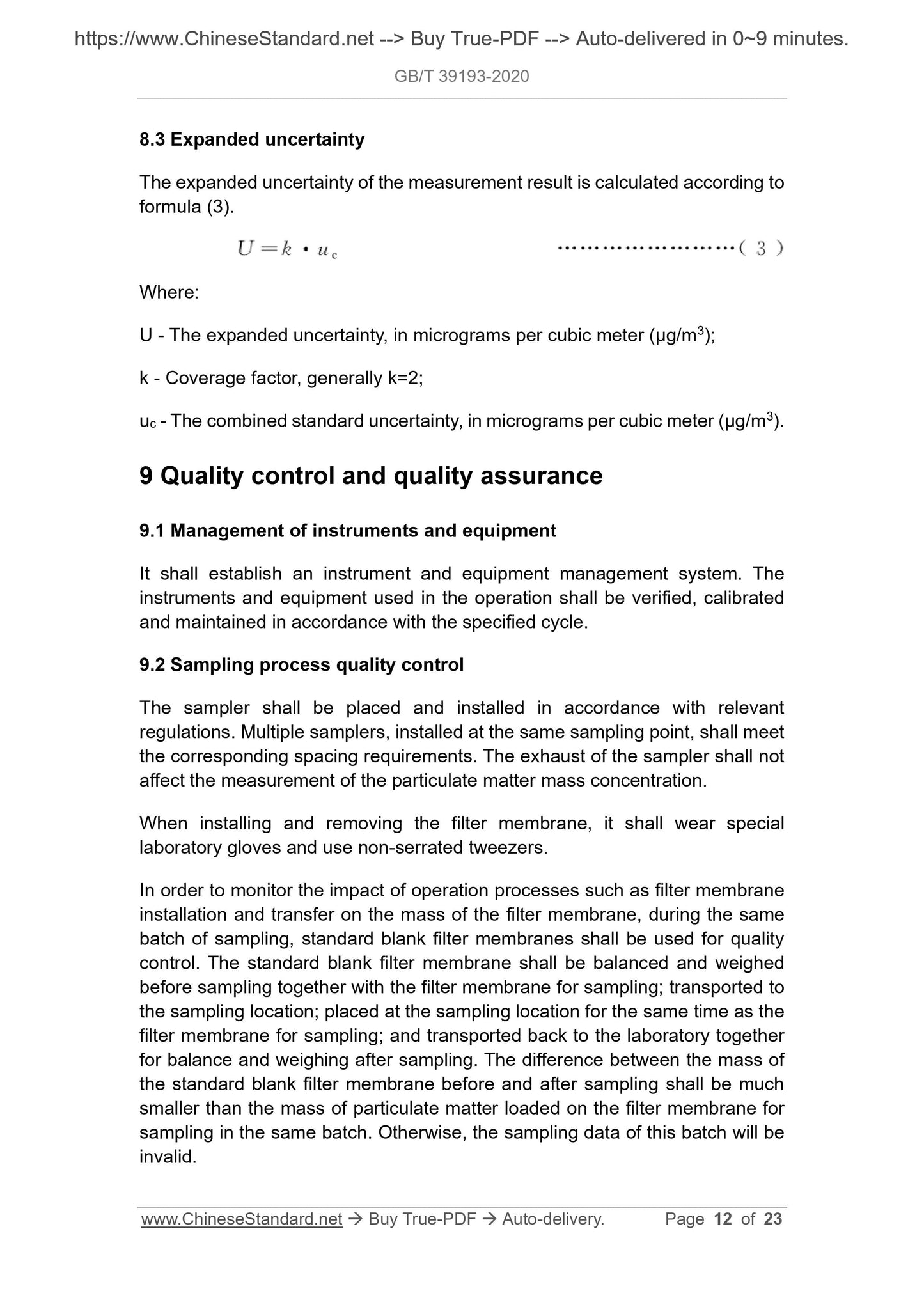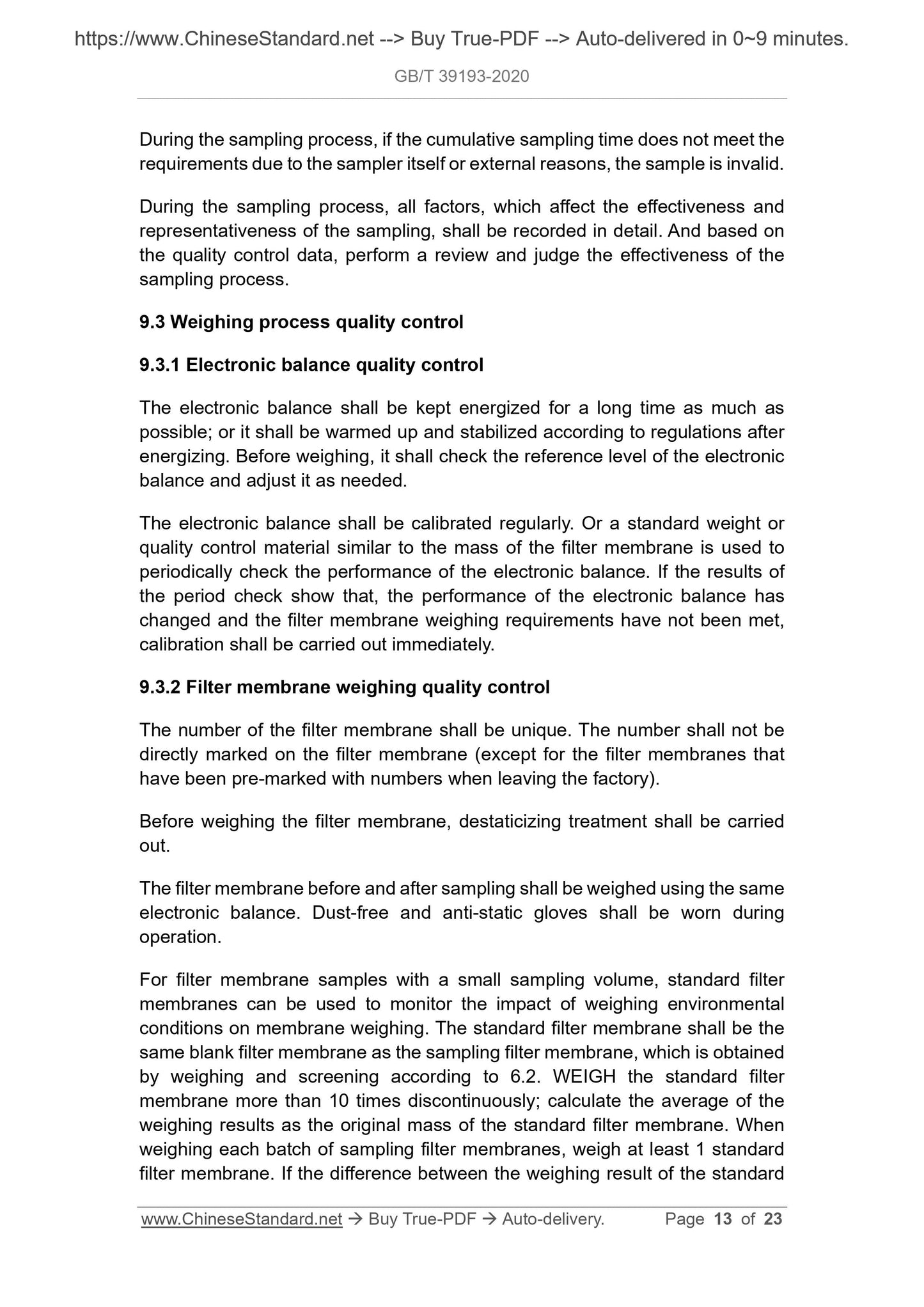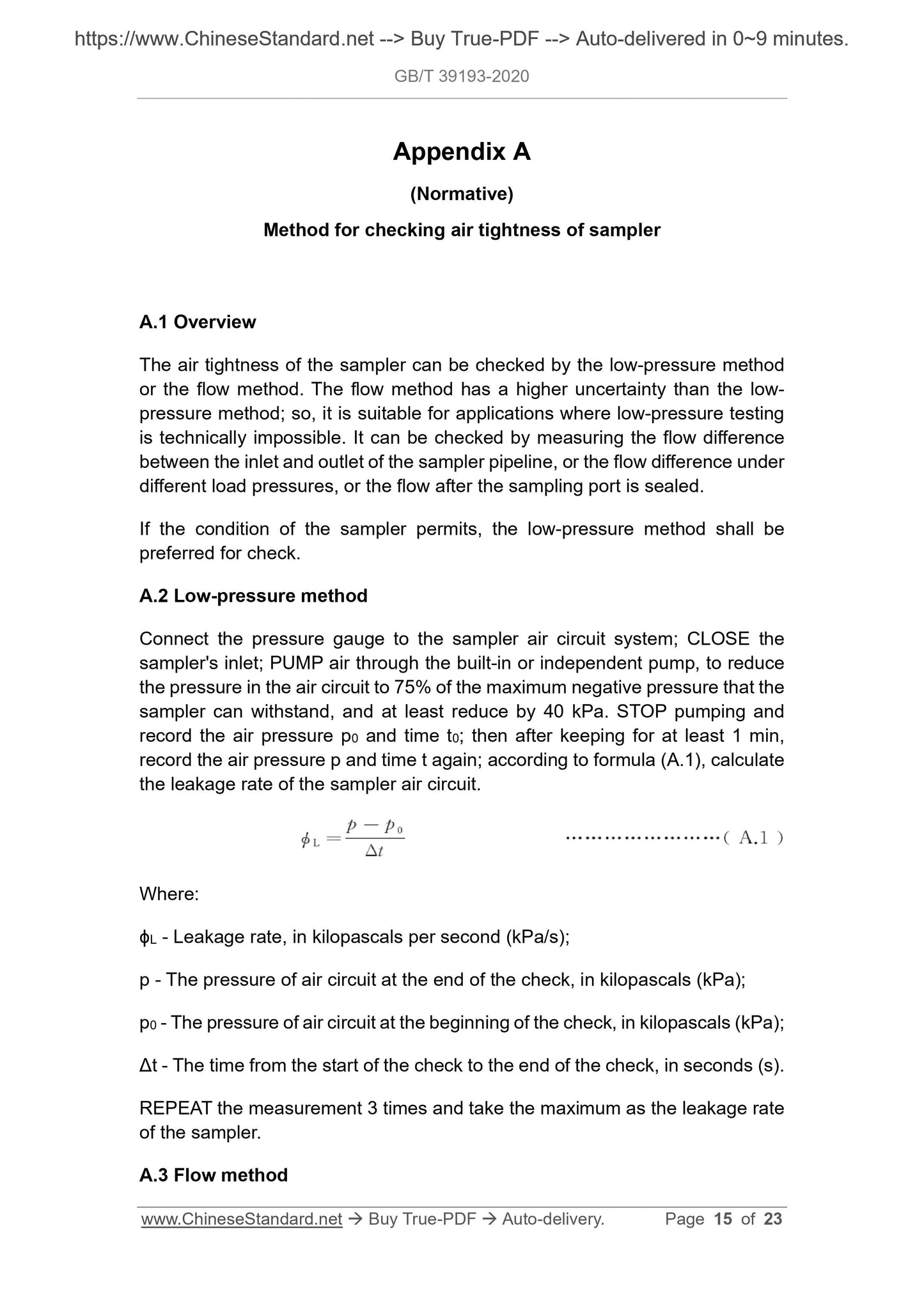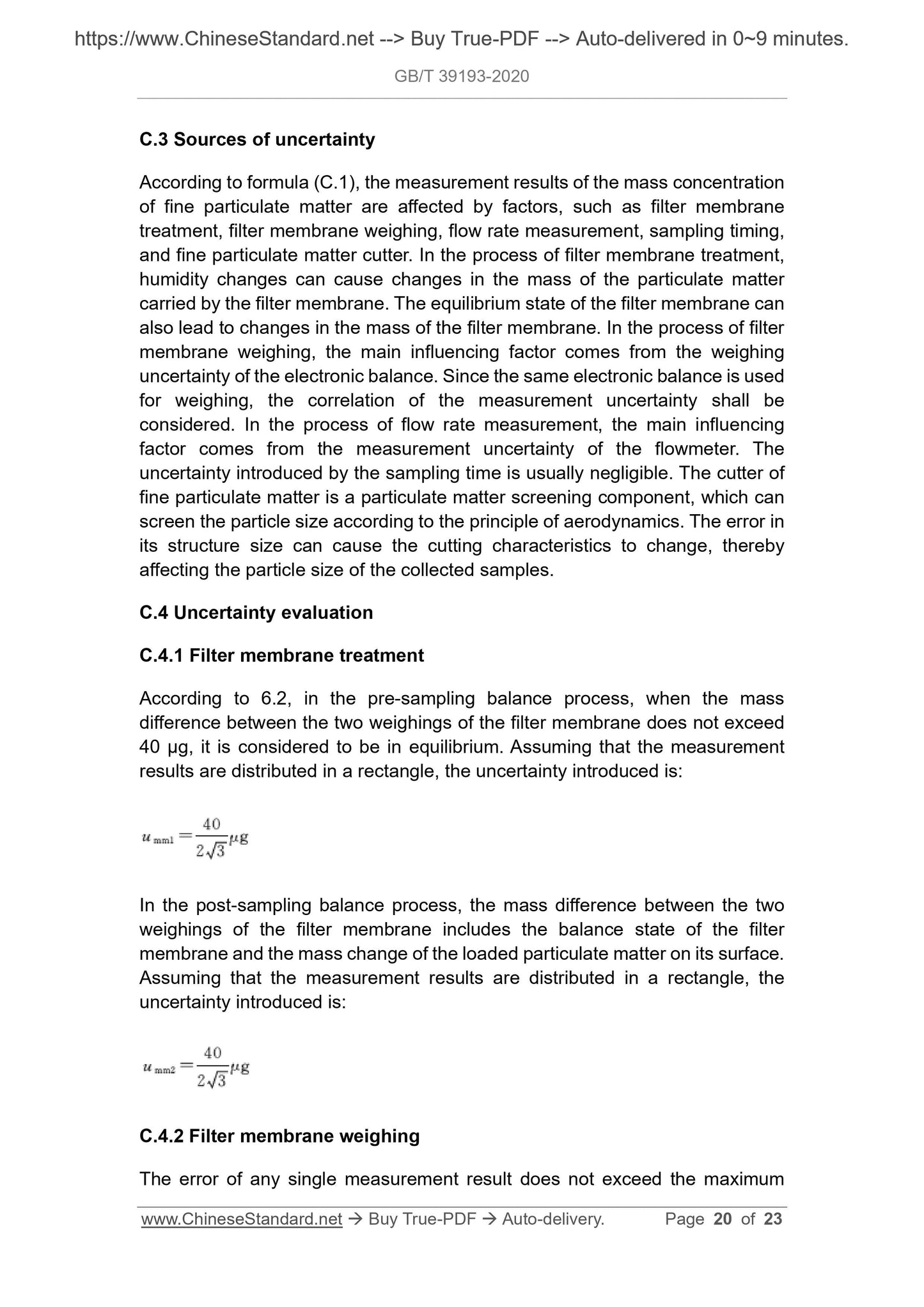1
/
of
9
www.ChineseStandard.us -- Field Test Asia Pte. Ltd.
GB/T 39193-2020 English PDF (GB/T39193-2020)
GB/T 39193-2020 English PDF (GB/T39193-2020)
Regular price
$245.00
Regular price
Sale price
$245.00
Unit price
/
per
Shipping calculated at checkout.
Couldn't load pickup availability
GB/T 39193-2020: Ambient air - Determination of particulate matter mass concentration - Gravimetric method
Delivery: 9 seconds. Download (& Email) true-PDF + Invoice.
Get Quotation: Click GB/T 39193-2020 (Self-service in 1-minute)
Historical versions (Master-website): GB/T 39193-2020
Preview True-PDF (Reload/Scroll-down if blank)
GB/T 39193-2020
GB
NATIONAL STANDARD OF THE
PEOPLE’S REPUBLIC OF CHINA
ICS 19.120
A 28
Ambient air - Determination of particulate matter mass
concentration - Gravimetric method
ISSUED ON: OCTOBER 11, 2020
IMPLEMENTED ON: MAY 01, 2021
Issued by: State Administration for Market Regulation;
Standardization Administration of the PRC.
Table of Contents
Foreword ... 3
Introduction ... 4
1 Scope ... 5
2 Normative references ... 5
3 Terms and definitions ... 5
4 Principle and method ... 6
5 Instruments and equipment... 6
6 Sampling and weighing ... 8
7 Calculation and presentation of results ... 10
8 Uncertainty evaluation of measurement results ... 11
9 Quality control and quality assurance ... 12
Appendix A (Normative) Method for checking air tightness of sampler ... 15
Appendix B (Normative) Method for checking flow rate of sampler ... 17
Appendix C (Informative) Example of uncertainty evaluation for measurement
of particulate matter mass concentration ... 19
Bibliography ... 23
Ambient air - Determination of particulate matter mass
concentration - Gravimetric method
1 Scope
This Standard specifies the method of filter membrane sampling and weighing
for the determination of particulate matter in ambient air, including principle and
method, instruments and equipment, sampling and weighing, calculation and
presentation of results, uncertainty evaluation of measurement results, quality
control and quality assurance.
This Standard applies to the use of filter membrane weighing method to
measure the particulate matter mass concentration in ambient air.
2 Normative references
The following documents are indispensable for the application of this document.
For the dated references, only the editions with the dates indicated are
applicable to this document. For the undated references, the latest edition
(including all the amendments) are applicable to this document.
GB/T 4883 Statistical interpretation of data - Detection and treatment of
outliers in the normal sample
GB/T 8170 Rules of rounding off for numerical values and expression and
judgement of limiting values
GB/T 26497 Electronic balance
JJF 1059.1 Evaluation and Expression of Uncertainty in Measurement
3 Terms and definitions
The following terms and definitions apply to this document.
3.1
Particulate matter; PM
The particulate matter in ambient air.
Medium-flow flowmeter: Range is 50 L/min~800 L/min; maximum allowable
error: ±2%;
Small-flow flowmeter: less than 50 L/min; maximum allowable error: ±2%.
5.4 Standard thermometer
It is used to measure the ambient temperature and calibrate the temperature
measurement parts of the sampler and constant-temperature and -humidity
equipment. The measurement range is -30 °C~50 °C. The maximum allowable
error is ±0.5 °C.
5.5 Standard hygrometer
It is used to measure the ambient humidity and calibrate the humidity
measurement parts of the constant-temperature and -humidity equipment.
Measurement range: relative humidity 40%~60%; maximum allowable error:
±2%.
5.6 Standard barometer
It is used to measure the atmospheric pressure of the environment and calibrate
the atmospheric pressure measurement parts of the sampler. Measurement
range: 50 kPa~107 kPa; maximum allowable error: ±0.25 kPa.
5.7 Standard stopwatch
It is used to check the timing parts of the sampler. Division value: 0.01 s.
5.8 Electronic balance
It is used for filter membrane weighing. According to the sampling volume and
filter membrane mass, an electronic balance with an appropriate weighing
range and division value shall be selected. Generally, the sampling mass shall
be greater than 100 times the division value of the electronic balance. The
division value of the electronic balance shall not be greater than 0.01 mg. The
technical performance shall meet the requirements of GB/T 26497.
The electronic balance shall be placed in an environment with the same
temperature and humidity control conditions as the constant-temperature and -
humidity equipment.
5.9 Constant-temperature and -humidity equipment
It is used to balance the temperature and humidity of the filter membrane before
and after sampling. Temperature control range: 15 °C~30 °C; temperature
fluctuation: ±1 °C. Relative humidity control range: relative humidity 45%~55%.
temperature indication error exceeds this range, the sampler shall be calibrated
for temperature.
6.1.6 Sampler atmospheric pressure measurement check and calibration
The standard barometer shall be used regularly to check the atmospheric
pressure indication error of the sampler. The maximum allowable error is ±1
kPa. If the indication error exceeds this range, pressure calibration shall be
performed on the sampler.
6.1.7 Temperature and humidity control check of constant-temperature
and -humidity equipment
Standard thermometers and standard hygrometers shall be used regularly, to
check the temperature and humidity indication errors and the temperature and
humidity fluctuation ranges of the constant-temperature and -humidity
equipment, to ensure that the constant-temperature and -humidity conditions
meet the requirements in 5.9.
6.1.8 Filter membrane check
The filter membrane shall have flat edges, uniform thickness, no burrs, no
pollution on the surface, no pinholes or damage.
6.2 Filter membrane balance and weighing before sampling
PLACE the uniquely-identified filter membrane in a constant-temperature and -
humidity equipment to balance for at least 24 h. RECORD the equilibrium
temperature and humidity of the filter membrane. USE a balance to weigh the
filter membrane and record the mass and number of the filter membrane.
After the first weighing, place it under the same equilibrium conditions for at
least 1 h before weighing again. The difference between the two weighed
masses of the same filter membrane shall not exceed ±40 μg (for medium-flow
or small-flow samplers) or ±0.4 mg (for large-flow samplers). If it exceeds this
range, the filter membrane is invalid. TAKE the average of the two weighing
results as the mass of the filter membrane.
6.3 Sampling operation
In a clean environment, use tweezers to put the weighed filter membrane into
the filter membrane holder. The rough surface of the filter membrane shall face
the direction of air intake. PUT the filter membrane holder into the sampler; SET
the parameters such as sampling time; START the sampler for sampling.
After sampling, put the filter membrane in a sealed, independent storage box;
8.3 Expanded uncertainty
The expanded uncertainty of the measurement result is calculated according to
formula (3).
Where:
U - The expanded uncertainty, in micrograms per cubic meter (μg/m3);
k - Coverage factor, generally k=2;
uc - The combined standard uncertainty, in micrograms per cubic meter (μg/m3).
9 Quality control and quality assurance
9.1 Management of instruments and equipment
It shall establish an instrument and equipment management system. The
instruments and equipment used in the operation shall be verified, calibrated
and maintained in accordance with the specified cycle.
9.2 Sampling process quality control
The sampler shall be placed and installed in accordance with relevant
regulations. Multiple samplers, installed at the same sampling point, shall meet
the corresponding spacing requirements. The exhaust of the sampler shall not
affect the measurement of the particulate matter mass concentration.
When installing and removing the filter membrane, it shall wear special
laboratory gloves and use non-serrated tweezers.
In order to monitor the impact of operation processes such as filter membrane
installation and transfer on the mass of the filter membrane, during the same
batch of sampling, standard blank filter membranes shall be used for quality
control. The standard blank filter membrane shall be balanced and weighed
before sampling together with the filter membrane for sampling; transported to
the sampling location; placed at the sampling location for the same time as the
filter membrane for sampling; and transported back to the laboratory together
for balance and weighing after sampling. The difference between the mass of
the standard blank filter membrane before and after sampling shall be much
smaller than the mass of particulate matter loaded on the filter membrane for
sampling in the same batch. Otherwise, the sampling data of this batch will be
invalid.
During the sampling process, if the cumulative sampling time does not meet the
requirements due to the sampler itself or external reasons, the sample is invalid.
During the sampling process, all factors, which affect the effectiveness and
representativeness of the sampling, shall be recorded in detail. And based on
the quality control data, perform a review and judge the effectiveness of the
sampling process.
9.3 Weighing process quality control
9.3.1 Electronic balance quality control
The electronic balance shall be kept energized for a long time as much as
possible; or it shall be warmed up and stabilized according to regulations after
energizing. Before weighing, it shall check the reference level of the electronic
balance and adjust it as needed.
The electronic balance shall be calibrated regularly. Or a standard weight or
quality control material similar to the mass of the filter membrane is used to
periodically check the performance of the electronic balance. If the results of
the period check show that, the performance of the electronic balance has
changed and the filter membrane weighing requirements have not been met,
calibration shall be carried out immediately.
9.3.2 Filter membrane weighing quality control
The number of the filter membrane shall be unique. The number shall not be
directly marked on the filter membrane (except for the filter membranes that
have been pre-marked with numbers when leaving the factory).
Before weighing the filter membrane, destaticizing treatment shall be carried
out.
The filter membrane before and after sampling shall be weighed using the same
electronic balance. Dust-free and anti-static gloves shall be worn during
operation.
For filter membrane samples with a small sampling volume, standard filter
membranes can be used to monitor the impact of weighing environmental
conditions on membrane weighing. The standard filter membrane shall be the
same blank filter membrane as the sampling filter membrane, which is obtained
by weighing and screening according to 6.2. WEIGH the standard filter
membrane more than 10 times discontinuously; calculate the average of the
weighing results as the original mass of the standard filter membrane. When
weighing each batch of sampling filter membranes, weigh at least 1 standard
filter membrane. If the difference between the weighing result of the standard
Appendix A
(Normative)
Method for checking air tightness of sampler
A.1 Overview
The air tightness of the sampler can be checked by the low-pressure method
or the flow method. The flow method has a higher uncertainty than the low-
pressure method; so, it is suitable for applications where low-pressure testing
is technically impossible. It can be checked by measuring the flow difference
between the inlet and outlet of the sampler pipeline, or the flow difference under
different load pressures, or the flow after the sampling port is sealed.
If the condition of the sampler permits, the low-pressure method shall be
preferred for check.
A.2 Low-pressure method
Connect the pressure gauge to the sampler air circuit system; CLOSE the
sampler's inlet; PUMP air through the built-in or independent pump, to reduce
the pressure in the air circuit to 75% of the maximum negative pressure that the
sampler can withstand, and at least reduce by 40 kPa. STOP pumping and
record the air pressure p0 and time t0; then after keeping for at least 1 min,
record the air pressure p and time t again; according to formula (A.1), calculate
the leakage rate of the sampler air circuit.
Where:
ϕL - Leakage rate, in kilopascals per second (kPa/s);
p - The pressure of air circuit at the end of the check, in kilopascals (kPa);
p0 - The pressure of air circuit at the beginning of the check, in kilopascals (kPa);
Δt - The time from the start of the check to the end of the check, in seconds (s).
REPEAT the measurement 3 times and take the maximum as the leakage rate
of the sampler.
A.3 Flow method
C.3 Sources of uncertainty
According to formula (C.1), the measurement results of the mass concentration
of fine particulate matter are affected by factors, such as filter membrane
treatment, filter membrane weighing, flow rate measurement, sampling timing,
and fine particulate matter cutter. In the process of filter membrane treatment,
humidity changes can cause changes in the mass of the particulate matter
carried by the filter membrane. The equilibrium state of the filter membrane can
also lead to changes in the mass of the filter membrane. In the process of filter
membrane weighing, the main influencing factor comes from the weighing
uncertainty of the electronic balance. Since the same electronic balance is used
for weighing, the correlation of the measurement uncertainty shall be
considered. In the process of flow rate measurement, the main influencing
factor comes from the measurement uncertainty of the flowmeter. The
uncertainty introduced by the sampling time is usually negligible. The cutter of
fine particulate matter is a particulate matter screening component, which can
screen the particle size according to the principle of aerodynamics. The error in
its structure size can cause the cutting characteristics to change, thereby
affecting the particle size of the collected samples.
C.4 Uncertainty evaluation
C.4.1 Filter membrane treatment
According to 6.2, in the pre-sampling balance process, when the mass
difference between the two weighings of the filter me...
Delivery: 9 seconds. Download (& Email) true-PDF + Invoice.
Get Quotation: Click GB/T 39193-2020 (Self-service in 1-minute)
Historical versions (Master-website): GB/T 39193-2020
Preview True-PDF (Reload/Scroll-down if blank)
GB/T 39193-2020
GB
NATIONAL STANDARD OF THE
PEOPLE’S REPUBLIC OF CHINA
ICS 19.120
A 28
Ambient air - Determination of particulate matter mass
concentration - Gravimetric method
ISSUED ON: OCTOBER 11, 2020
IMPLEMENTED ON: MAY 01, 2021
Issued by: State Administration for Market Regulation;
Standardization Administration of the PRC.
Table of Contents
Foreword ... 3
Introduction ... 4
1 Scope ... 5
2 Normative references ... 5
3 Terms and definitions ... 5
4 Principle and method ... 6
5 Instruments and equipment... 6
6 Sampling and weighing ... 8
7 Calculation and presentation of results ... 10
8 Uncertainty evaluation of measurement results ... 11
9 Quality control and quality assurance ... 12
Appendix A (Normative) Method for checking air tightness of sampler ... 15
Appendix B (Normative) Method for checking flow rate of sampler ... 17
Appendix C (Informative) Example of uncertainty evaluation for measurement
of particulate matter mass concentration ... 19
Bibliography ... 23
Ambient air - Determination of particulate matter mass
concentration - Gravimetric method
1 Scope
This Standard specifies the method of filter membrane sampling and weighing
for the determination of particulate matter in ambient air, including principle and
method, instruments and equipment, sampling and weighing, calculation and
presentation of results, uncertainty evaluation of measurement results, quality
control and quality assurance.
This Standard applies to the use of filter membrane weighing method to
measure the particulate matter mass concentration in ambient air.
2 Normative references
The following documents are indispensable for the application of this document.
For the dated references, only the editions with the dates indicated are
applicable to this document. For the undated references, the latest edition
(including all the amendments) are applicable to this document.
GB/T 4883 Statistical interpretation of data - Detection and treatment of
outliers in the normal sample
GB/T 8170 Rules of rounding off for numerical values and expression and
judgement of limiting values
GB/T 26497 Electronic balance
JJF 1059.1 Evaluation and Expression of Uncertainty in Measurement
3 Terms and definitions
The following terms and definitions apply to this document.
3.1
Particulate matter; PM
The particulate matter in ambient air.
Medium-flow flowmeter: Range is 50 L/min~800 L/min; maximum allowable
error: ±2%;
Small-flow flowmeter: less than 50 L/min; maximum allowable error: ±2%.
5.4 Standard thermometer
It is used to measure the ambient temperature and calibrate the temperature
measurement parts of the sampler and constant-temperature and -humidity
equipment. The measurement range is -30 °C~50 °C. The maximum allowable
error is ±0.5 °C.
5.5 Standard hygrometer
It is used to measure the ambient humidity and calibrate the humidity
measurement parts of the constant-temperature and -humidity equipment.
Measurement range: relative humidity 40%~60%; maximum allowable error:
±2%.
5.6 Standard barometer
It is used to measure the atmospheric pressure of the environment and calibrate
the atmospheric pressure measurement parts of the sampler. Measurement
range: 50 kPa~107 kPa; maximum allowable error: ±0.25 kPa.
5.7 Standard stopwatch
It is used to check the timing parts of the sampler. Division value: 0.01 s.
5.8 Electronic balance
It is used for filter membrane weighing. According to the sampling volume and
filter membrane mass, an electronic balance with an appropriate weighing
range and division value shall be selected. Generally, the sampling mass shall
be greater than 100 times the division value of the electronic balance. The
division value of the electronic balance shall not be greater than 0.01 mg. The
technical performance shall meet the requirements of GB/T 26497.
The electronic balance shall be placed in an environment with the same
temperature and humidity control conditions as the constant-temperature and -
humidity equipment.
5.9 Constant-temperature and -humidity equipment
It is used to balance the temperature and humidity of the filter membrane before
and after sampling. Temperature control range: 15 °C~30 °C; temperature
fluctuation: ±1 °C. Relative humidity control range: relative humidity 45%~55%.
temperature indication error exceeds this range, the sampler shall be calibrated
for temperature.
6.1.6 Sampler atmospheric pressure measurement check and calibration
The standard barometer shall be used regularly to check the atmospheric
pressure indication error of the sampler. The maximum allowable error is ±1
kPa. If the indication error exceeds this range, pressure calibration shall be
performed on the sampler.
6.1.7 Temperature and humidity control check of constant-temperature
and -humidity equipment
Standard thermometers and standard hygrometers shall be used regularly, to
check the temperature and humidity indication errors and the temperature and
humidity fluctuation ranges of the constant-temperature and -humidity
equipment, to ensure that the constant-temperature and -humidity conditions
meet the requirements in 5.9.
6.1.8 Filter membrane check
The filter membrane shall have flat edges, uniform thickness, no burrs, no
pollution on the surface, no pinholes or damage.
6.2 Filter membrane balance and weighing before sampling
PLACE the uniquely-identified filter membrane in a constant-temperature and -
humidity equipment to balance for at least 24 h. RECORD the equilibrium
temperature and humidity of the filter membrane. USE a balance to weigh the
filter membrane and record the mass and number of the filter membrane.
After the first weighing, place it under the same equilibrium conditions for at
least 1 h before weighing again. The difference between the two weighed
masses of the same filter membrane shall not exceed ±40 μg (for medium-flow
or small-flow samplers) or ±0.4 mg (for large-flow samplers). If it exceeds this
range, the filter membrane is invalid. TAKE the average of the two weighing
results as the mass of the filter membrane.
6.3 Sampling operation
In a clean environment, use tweezers to put the weighed filter membrane into
the filter membrane holder. The rough surface of the filter membrane shall face
the direction of air intake. PUT the filter membrane holder into the sampler; SET
the parameters such as sampling time; START the sampler for sampling.
After sampling, put the filter membrane in a sealed, independent storage box;
8.3 Expanded uncertainty
The expanded uncertainty of the measurement result is calculated according to
formula (3).
Where:
U - The expanded uncertainty, in micrograms per cubic meter (μg/m3);
k - Coverage factor, generally k=2;
uc - The combined standard uncertainty, in micrograms per cubic meter (μg/m3).
9 Quality control and quality assurance
9.1 Management of instruments and equipment
It shall establish an instrument and equipment management system. The
instruments and equipment used in the operation shall be verified, calibrated
and maintained in accordance with the specified cycle.
9.2 Sampling process quality control
The sampler shall be placed and installed in accordance with relevant
regulations. Multiple samplers, installed at the same sampling point, shall meet
the corresponding spacing requirements. The exhaust of the sampler shall not
affect the measurement of the particulate matter mass concentration.
When installing and removing the filter membrane, it shall wear special
laboratory gloves and use non-serrated tweezers.
In order to monitor the impact of operation processes such as filter membrane
installation and transfer on the mass of the filter membrane, during the same
batch of sampling, standard blank filter membranes shall be used for quality
control. The standard blank filter membrane shall be balanced and weighed
before sampling together with the filter membrane for sampling; transported to
the sampling location; placed at the sampling location for the same time as the
filter membrane for sampling; and transported back to the laboratory together
for balance and weighing after sampling. The difference between the mass of
the standard blank filter membrane before and after sampling shall be much
smaller than the mass of particulate matter loaded on the filter membrane for
sampling in the same batch. Otherwise, the sampling data of this batch will be
invalid.
During the sampling process, if the cumulative sampling time does not meet the
requirements due to the sampler itself or external reasons, the sample is invalid.
During the sampling process, all factors, which affect the effectiveness and
representativeness of the sampling, shall be recorded in detail. And based on
the quality control data, perform a review and judge the effectiveness of the
sampling process.
9.3 Weighing process quality control
9.3.1 Electronic balance quality control
The electronic balance shall be kept energized for a long time as much as
possible; or it shall be warmed up and stabilized according to regulations after
energizing. Before weighing, it shall check the reference level of the electronic
balance and adjust it as needed.
The electronic balance shall be calibrated regularly. Or a standard weight or
quality control material similar to the mass of the filter membrane is used to
periodically check the performance of the electronic balance. If the results of
the period check show that, the performance of the electronic balance has
changed and the filter membrane weighing requirements have not been met,
calibration shall be carried out immediately.
9.3.2 Filter membrane weighing quality control
The number of the filter membrane shall be unique. The number shall not be
directly marked on the filter membrane (except for the filter membranes that
have been pre-marked with numbers when leaving the factory).
Before weighing the filter membrane, destaticizing treatment shall be carried
out.
The filter membrane before and after sampling shall be weighed using the same
electronic balance. Dust-free and anti-static gloves shall be worn during
operation.
For filter membrane samples with a small sampling volume, standard filter
membranes can be used to monitor the impact of weighing environmental
conditions on membrane weighing. The standard filter membrane shall be the
same blank filter membrane as the sampling filter membrane, which is obtained
by weighing and screening according to 6.2. WEIGH the standard filter
membrane more than 10 times discontinuously; calculate the average of the
weighing results as the original mass of the standard filter membrane. When
weighing each batch of sampling filter membranes, weigh at least 1 standard
filter membrane. If the difference between the weighing result of the standard
Appendix A
(Normative)
Method for checking air tightness of sampler
A.1 Overview
The air tightness of the sampler can be checked by the low-pressure method
or the flow method. The flow method has a higher uncertainty than the low-
pressure method; so, it is suitable for applications where low-pressure testing
is technically impossible. It can be checked by measuring the flow difference
between the inlet and outlet of the sampler pipeline, or the flow difference under
different load pressures, or the flow after the sampling port is sealed.
If the condition of the sampler permits, the low-pressure method shall be
preferred for check.
A.2 Low-pressure method
Connect the pressure gauge to the sampler air circuit system; CLOSE the
sampler's inlet; PUMP air through the built-in or independent pump, to reduce
the pressure in the air circuit to 75% of the maximum negative pressure that the
sampler can withstand, and at least reduce by 40 kPa. STOP pumping and
record the air pressure p0 and time t0; then after keeping for at least 1 min,
record the air pressure p and time t again; according to formula (A.1), calculate
the leakage rate of the sampler air circuit.
Where:
ϕL - Leakage rate, in kilopascals per second (kPa/s);
p - The pressure of air circuit at the end of the check, in kilopascals (kPa);
p0 - The pressure of air circuit at the beginning of the check, in kilopascals (kPa);
Δt - The time from the start of the check to the end of the check, in seconds (s).
REPEAT the measurement 3 times and take the maximum as the leakage rate
of the sampler.
A.3 Flow method
C.3 Sources of uncertainty
According to formula (C.1), the measurement results of the mass concentration
of fine particulate matter are affected by factors, such as filter membrane
treatment, filter membrane weighing, flow rate measurement, sampling timing,
and fine particulate matter cutter. In the process of filter membrane treatment,
humidity changes can cause changes in the mass of the particulate matter
carried by the filter membrane. The equilibrium state of the filter membrane can
also lead to changes in the mass of the filter membrane. In the process of filter
membrane weighing, the main influencing factor comes from the weighing
uncertainty of the electronic balance. Since the same electronic balance is used
for weighing, the correlation of the measurement uncertainty shall be
considered. In the process of flow rate measurement, the main influencing
factor comes from the measurement uncertainty of the flowmeter. The
uncertainty introduced by the sampling time is usually negligible. The cutter of
fine particulate matter is a particulate matter screening component, which can
screen the particle size according to the principle of aerodynamics. The error in
its structure size can cause the cutting characteristics to change, thereby
affecting the particle size of the collected samples.
C.4 Uncertainty evaluation
C.4.1 Filter membrane treatment
According to 6.2, in the pre-sampling balance process, when the mass
difference between the two weighings of the filter me...
Share
